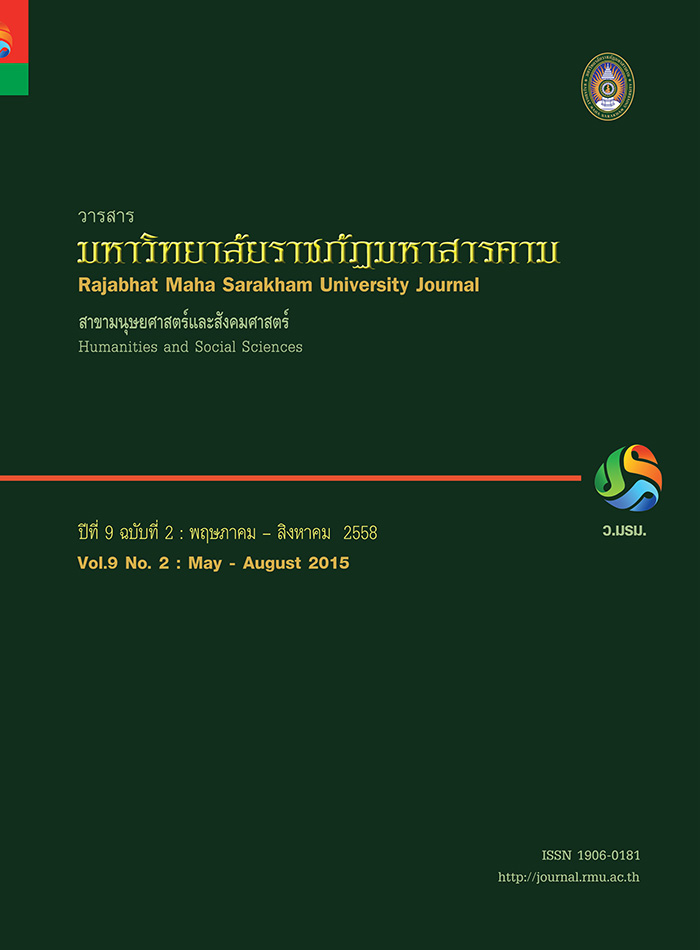รูปแบบการดำเนินงานสหกิจศึกษาเพื่อพัฒนาศักยภาพของนักศึกษาหลักสูตรเทคโนโลยีบัณฑิต AModel for Implementation of Cooperative Education to Develop Technology Students’ Efficiency
Main Article Content
Abstract
การวิจัยนี้มีวัตถุประสงค์ 1) เพื่อศึกษาวิธีการดำเนินงานสหกิจศึกษาเพื่อพัฒนาศักยภาพของนักศึกษาหลักสูตรเทคโนโลยีบัณฑิต ที่มี
ประสิทธิผลจากสถานศึกษาต้นแบบ 2) เพื่อสร้างรูปแบบ การดำเนินงานสหกิจศึกษาเพื่อพัฒนาศักยภาพของนักศึกษาหลักสูตรเทคโนโลยี
บัณฑิต และ 3) เพื่อทดลองใช้และประเมินผลการใช้รูปแบบการดำเนินงานสหกิจศึกษาเพื่อพัฒนาศักยภาพของนักศึกษาหลักสูตร
เทคโนโลยีบัณฑิต วิธีดำเนินการวิจัยแบ่งเป็น 3 ระยะ คือ
ระยะที่ 1 เป็นการวิจัยเชิงปริมาณ เพื่อศึกษาวิธีการดำเนินงานสหกิจศึกษาเพื่อพัฒนาศักยภาพของนักศึกษาหลักสูตร
เทคโนโลยีบัณฑิต เครื่องมือที่ใช้รวบรวมข้อมูลได้แก่ แบบสอบถามวิธีการดำเนินงานสหกิจศึกษาทั้ง 3 ด้านได้แก่ด้านสถานศึกษา ด้าน
สถานประกอบการ ด้านนักศึกษา โดยสอบถามผู้บริหาร อาจารย์นิเทศงานสหกิจศึกษาและเจ้าหน้าที่สหกิจศึกษาในสถานศึกษาต้นแบบ
ประกอบด้วย ผู้บริหาร 2 คน อาจารย์นิเทศงานสหกิจศึกษา 6 คน และเจ้าหน้าที่สหกิจศึกษาจำนวน 10 คน โดยวิธีคัดเลือกแบบเฉพาะ
เจาะจง จากมหาวิทยาลัยเทคโนโลยีราชมงคลอีสาน วิทยาเขตขอนแก่น ผลการวิจัย พบว่า มหาวิทยาลัยมีวิธีการดำเนินงานสหกิจศึกษา
ที่มีประสิทธิผลโดยมีแผนการดำเนินงานสหกิจศึกษาที่ชัดเจนเป็นรูปธรรม กำหนดแผนปฏิบัติงานต่างๆ เป็นยุทธศาสตร์ มีโครงการ
รองรับแผนยุทธ์ศาสตร์แต่ละด้านเพื่อให้เกิดผลสัมฤทธิ์ มีการประเมินผลและนำผลการประเมินไปใช้งานจริงและยึดแนวทางการดำเนิน
งานสหกิจศึกษาตามมาตรฐานการดำเนินงานสหกิจศึกษาไทย ของสำนักงานคณะกรรมการการอุดมศึกษา
ระยะที่ 2 เป็นการวิจัยเชิงคุณภาพ เพื่อสร้างรูปแบบการดำเนินงานสหกิจศึกษาเพื่อพัฒนาศักยภาพของนักศึกษาหลักสูตร
เทคโนโลยีบัณฑิต โดยการนำผลการวิจัยในระยะที่ 1 มาสร้างรูปแบบการดำเนินงานสหกิจศึกษาเพื่อพัฒนาศักยภาพของนักศึกษา
หลักสูตรเทคโนโลยีบัณฑิต โดยการจัดประชุมเชิงปฏิบัติการ (Workshops) และใช้การประชุมกลุ่มย่อย (Focus Groups) และการ
ระดมสมอง (Brain Storming) ผลการวิจัย พบว่า รูปแบบการดำเนินงานสหกิจศึกษาเพื่อพัฒนาศักยภาพของนักศึกษาหลักสูตร
เทคโนโลยีบัณฑิตที่สร้างขึ้น มีโครงการที่ผ่านการประเมินความเห็นชอบ จากผู้เชี่ยวชาญครอบคลุมปัจจัยทั้ง 3 ด้าน ได้แก่ ด้านสถาน
ศึกษา จำนวน 14 โครงการ ด้านสถานประกอบการ จำนวน 6 โครงการ และด้านนักศึกษา จำนวน 8 โครงการ
ระยะที่ 3 เป็นการทดลองใช้และประเมินผลการใช้รูปแบบการดำเนินงานสหกิจศึกษาเพื่อพัฒนาศักยภาพของนักศึกษา
หลักสูตรเทคโนโลยีบัณฑิต กลุ่มทดลอง ได้แก่ กลุ่มนักวิชาการหรือผู้เชี่ยวชาญ 5 คน กลุ่มอาจารย์นิเทศงานสหกิจศึกษา 5 คน กลุ่ม
พนักงานพี่เลี้ยงในสถานประกอบการ 5 คน ตัวแทนนักศึกษา ชั้นปีที่ 4 หลักสูตรเทคโนโลยีบัณฑิต 5 คน รวมเป็น 20 คนในศูนย์
วิทยาลัยเทคนิคหนองคาย คณะครุศาสตร์อุตสาหกรรมและเทคโนโลยี มหาวิทยาลัยเทคโนโลยีพระจอมเกล้าธนบุรี โดยใช้วิธีการคัด
เลือกแบบเฉพาะเจาะจง ทำการรวบรวมข้อมูลใช้รูปแบบการดำเนินงานสหกิจศึกษาเพื่อพัฒนาศักยภาพของนักศึกษาหลักสูตรเทคโนโลยี
บัณฑิต ที่ผู้วิจัยสร้างขึ้นทดลองใช้ 1 ภาคเรียน การประเมินผลศักยภาพการปฏิบัติงานของนักศึกษา แบ่งออกเป็น 2 ส่วน คือ 1) ก่อน
การทดลองประเมินศักยภาพการปฏิบัติงานของนักศึกษา ด้วยแบบประเมินที่ผู้วิจัยสร้างขึ้น โดยรวบรวมข้อมูลกับกลุ่มนักศึกษาหลักสูตร
เทคโนโลยีบัณฑิต จำนวน 60 คน ที่ทดลอง จากศูนย์วิทยาลัยเทคนิคหนองคาย และ 2) หลังการทดลอง ประเมินศักยภาพการปฏิบัติ
งานของนักศึกษา ด้วยแบบประเมินชุดเดิม รวบรวมข้อมูลเปรียบเทียบก่อนการทดลองและหลังการทดลองด้วย MANOVA
ผลการวิจัยพบว่า รูปแบบการดำเนินงานสหกิจศึกษาเพื่อพัฒนาศักยภาพของนักศึกษาหลักสูตรเทคโนโลยีบัณฑิต ส่งผลให้เกิด
การพัฒนาศักยภาพของนักศึกษาเพิ่มขึ้นมากกว่าก่อนการทดลองอย่างมีนัยสำคัญทางสถิติที่ระดับ .05
This research has the following objectives: 1) to research the requirements for an effective model of
cooperative education to develop technology students’ efficiency, 2) to construct that model 3) to experiment
with the model and evaluate it. The research was divided into three phases as follows:
Phase 1 was a quantitative research study on implementation approaches to cooperative education
to develop technology students’ efficiency in three dimensions: 1) educational institutes, 2) places for
apprenticeship, and 3) technology students. A descriptive data analysis method was used. A questionnaire
was used for data collection from educational administrators, pedagogical advisors and cooperative education
officials, and technology students. The sample was 2 educational administrators, 6 pedagogical advisors, 10
cooperative education officials of Rajamangala University of Technology IsanKhonKaen Campus regional
zone. The purposive sampling technique was used.The findings found that the most effective approach in
implementation of cooperative education was that the university required: a concrete and clear cooperative
education master work plan, strategies based on the master work plan, projects implementing requirements
to achieve each strategy, a monitoring and evaluation plan, and implementation of cooperative education
based on the Thai Cooperative Education Standard from the Commission of Higher Education.
Phase 2 was qualitative research on the results from Phase 1 to construct the model. Phase 1 findings
were discussed and criticized in a workshop, including focus group discussion and brainstorming.It was
found that in order to construct an effective model encompassing the three dimensions in which the experts
agreed with, there were 14 activities for educational institutes, six activities for places of apprenticeship, and
eight activities for students.
Phase 3 was implementation and evaluation of the model. The targets for implementing the model were
five educational administrators, five pedagogical advisors on cooperative education, five officials from the
places for apprenticeship, and five technology students from NongKhai Technical College of King Mongkut’s
University of Technology Thonburi, for a total of 20 people. The target groups were purposively sampled. The
model was implemented in NongKhai Technical College of King Mongkut’s University of Technology Thonburi
for one semester. Data was collected from the targets for two periods: 1) before the implementation of the
model to obtain pre-test data, and 2) after the implementation of the model for post-test data. The pre-test
and post-test data were then compared and analyzed by using MANOVA.The findings indicated that the
efficiency of technology students increased compared to before implementing the model at statistically
significant level of .05.
Article Details
1. All articles undergo a thorough with at least three reviewers evaluating their suitability within the respective field of study, during the double-blind review.
2. The views expressed by individual authors do not represent the official views of the Editorial Boards of RMUJ: The author of each articie is responsible for all its contents.
3. The Editorial Boards do not reserve the copyrights. but proper citations need to be made.


